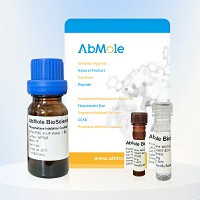All AbMole products are for research use only, cannot be used for human consumption.

Expression host: CHO cells
Purity: >95%. Sds-page gel and HIGH performance liquid chromatography were used
Endotoxin: <0.01 EU/μg
Storage and stability: stored at 2~8℃, valid for 24 months. In case of separate packaging, store in -20℃ storage period of 6 months, -80℃ storage period of 12 months, avoid repeated freeze-thaw.
Biological activity: PD-1 is mainly expressed in activated T cells and B cells, and its function is to inhibit cell activation, which is a normal self-stabilizing mechanism of the immune system. Because excessive T/B cell activation can cause autoimmune diseases, PD-1 is a talisman of our body. However, the tumor microenvironment will induce the infiltrating T cells to overexpress the PD-1 molecule, and the tumor cells will also overexpress the PD-L1 and PD-L2 ligands of PD-1, resulting in the continuous activation of the PD-1 pathway in the tumor microenvironment, resulting in the inhibition of THE FUNCTION of T cells. Antibodies against PD-1 that fail to kill tumor cells can block this pathway, thereby partially restoring the function of T cells and enabling T cells to continue to kill tumor cells. Therefore, anti-HUMAN PD-1 monoclonal antibody was used to "block" the amplified T cells in vitro, thus significantly improving the killing effect of immune cells on the tumor in patients.
| Storage | 2-8℃ |
| Related Cytokines and Growth Factors Products |
|---|
| Recombinant Human GDF-15 Protein (HEK293 N-hFc)
Growth-differentiation factor 15 (GDF15), also known as MIC-1, is a secreted member of the transforming growth factor (TGF)-β superfamily. GDF-15 has a role in regulating inflammatory and apoptotic pathways in injured tissues and during disease processes. GDF-15 overexpression arising from an expanded erythroid compartment contributes to iron overload in thalassemia syndromes by inhibiting hepcidin expression. |
| Recombinant Human FGFR1 Protein (HEK293, C-His)
FGFR1, also known as CD331, is a full-length representative protein consists of an extracellular region, composed of three immunoglobulin-like domains, a single hydrophobic membrane-spanning segment and a cytoplasmic tyrosine kinase domain. |
| Recombinant Human FGFR2 Protein (HEK293, C-His)
FGFR2, also known as CD332, acts as cell-surface receptor for fibroblast growth factors and plays an essential role in the regulation of cell proliferation, differentiation, migration and apoptosis, and in the regulation of embryonic development. FGFR2 plays an essential role in the regulation of osteoblast differentiation, proliferation and apoptosis, and is required for normal skeleton development. It also promotes cell proliferation in keratinocytes and imature osteoblasts, but promotes apoptosis in differentiated osteoblasts. |
| Recombinant Mouse BMP-4 Protein (E. coli, C-His)
Bone Morphogenetic Protein-4 (BMP-4) is a critical signaling molecule required for the early differentiation of the embryo and establishing of a dorsal-ventral axis. BMP-4 is secreted from the dorsal portion of the notochord, and it acts in concert with sonic hedgehog to establish a dorsal-ventral axis for the differentiation of later structures. |
| Recombinant Human Coagulation Factor X (HEK293, C-Fc)
Coagulation factor X, belongs to the peptidase S1 family. Coagulation factor X is initially synthesized in the liver. Coagulation factor X is a vitamin K-dependent glycoprotein that converts prothrombin to thrombin in the presence of factor Va, calcium and phospholipid during blood clotting. |
All AbMole products are for research use only, cannot be used for human consumption or veterinary use. We do not provide products or services to individuals. Please comply with the intended use and do not use AbMole products for any other purpose.


Products are for research use only. Not for human use. We do not sell to patients.
© Copyright 2010-2024 AbMole BioScience. All Rights Reserved.
